The top 10 biodiversity success stories for the South Downs National Park – and looking ahead to the future
April 8, 2020
With its abundance of iconic birds, mammals, fish, plants, invertebrates and internationally-important habitats, the South Downs National Park is a haven for wildlife in the busiest part of the UK.
The fight to protect and enhance this beautiful sanctuary of flora and fauna is not without its challenges, not least the globally-recognised threats of climate change and human impacts.
But the designation of the South Downs National Park 10 years ago on March 31, 2010, marked a significant step forward.
And, in the 10 years since, great strides have been made to help improve biodiversity. This vital work is ongoing but the green shoots of recovery are evident for a number of species.
Indeed, the UK’s State of Nature Report 2019, which looked at not just what had been lost, but what needs to be fought for, highlighted “the range of internationally-important habitats, such as its lowland heathlands, ancient woodlands and chalk grasslands in the south”.
 Andrew Lee, Director of Countryside and Policy Management for the South Downs National Park, explains why biodiversity is so vital – for all of us!
Andrew Lee, Director of Countryside and Policy Management for the South Downs National Park, explains why biodiversity is so vital – for all of us!
“Biodiversity encompasses every living thing in all their forms and interactions,” he said.
“And it’s this incredibly complex network of nature that humanity relies on completely. The air we breathe, the water we drink, and the food we eat – all dependent on biodiversity.
“Animals and plants are also part of our cultural identity. Who can fail to be inspired by a walk on the South Downs and glimpsing blue butterflies hovering in a blanket of wildflowers, or the sight of a water vole on the river?
“The National Park has some of the rarest animals and plants in Britain and, without our collective efforts to give nature the space and protection to flourish, these ‘natural works of art’ could be lost forever.
“Biodiversity loss is global and unprecedented, with climate change only heightening the need for action. We’re working really hard to turn the tide on biodiversity loss on a big and small scale, through larger landscape projects and via smaller initiatives for individual species such as the Field Cricket.”
And, as the National Park enters its second decade, Andrew added that one of the key priorities will be producing a Nature Recovery Strategy that engages and collaborates with partner organisations, landowners and local communities.
Andrew explained: “The Defra 25-Year Plan, Environment Bill and of course, the Glover Review, are unequivocal – much more must be done to restore nature, and urgently, and National Parks must play a strong role in this.
“Our new Partnership Management Plan and the Local Plan establish a clear policy framework. Now we need more action on the ground.
“As a planning authority, we will be required to produce a Nature Recovery Strategy, but we want to go further than this and engage partners in a wider nature recovery campaign.
“We are also working with neighbouring AONBs and Local Nature Partnerships to create a nature recovery network across the wider South East.
“The need for action is clear and we should take the opportunity, be ambitious and move fast. The South Downs National Park Authority has a key role to play by showing leadership, using its convening power, and facilitating nature recovery.”
We now look at 10 biodiversity success stories for the National Park:
Two iconic cricket species
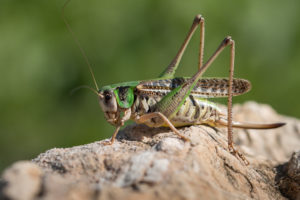 The South Downs remains the last bastion in the UK for the iconic Field Cricket, whose “cheep, cheep, cheep” is the quintessential sound of summer.
The South Downs remains the last bastion in the UK for the iconic Field Cricket, whose “cheep, cheep, cheep” is the quintessential sound of summer.
Thirty years ago the species was isolated to just one site of 100 field crickets in West Sussex. But a concerted effort, led by volunteers and conservation organisations, has helped to establish six colonies at heathland sites in Sussex, Surrey and Hampshire.
A favourite of South Downs National Park Ranger Charles Winchester, he says: “Hearing a field full of them singing on a warm day in May is a pretty special experience. Being part of the creation of new colonies has been a real highlight for me.”
The wart-biter bush cricket is one of the UK’s most endangered insects and gets its name from the ancient Swedish medical practice of using them to eat skin warts. It was once found across southern England but numbers have declined so dramatically that they are now found only in five locations, three in the South Downs.
A pioneering project has seen the rare insect reintroduced into new chalk grassland habitat around the Deep Dean Water Treatment Works in East Sussex, thanks to a collaboration between South East Water, Natural England, Buglife, and the Zoological Society of London.
Water Voles
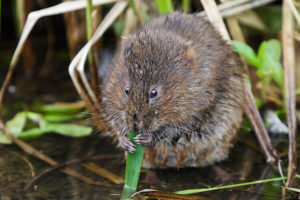
A species you may be lucky enough to spot on the River Meon in Hampshire, the water vole is the fastest declining mammal in the UK. During the 1990s, the UK population fell by almost 90 per cent.
Water voles are essentially ecosystem engineers – their burrowing and feeding behaviour along the edges of watercourses creates the conditions for other animals and plants to thrive.
The water vole has made a remarkable comeback in the South Downs National Park, thanks to the work of the Meon Valley Partnership, of which the SDNPA is a partner. Over six years, a total of 2,833 water voles have been released to 30 locations along the stretch of the river.
The project ticks every box for why the South Downs became a National Park – bringing volunteers, landowners and the local community together to care for landscapes and support wildlife.
Matt Owen-Farmer, from Portsmouth Services Fly Fishing Association, said: “Our rivers are under huge pressures and angling is just one of the demands we place upon them. Being part of the water vole project has enabled us to take a wider look at how we manage these habitats for everyone.”
Adam Cave, a Biodiversity Technical Specialist at the Environment Agency, added: “It’s been one of the best projects that I have worked on since joining the Environment Agency, so very rewarding, and it is great when people tell me that they have seen a Water vole on the Meon, or heard the classic ‘plop’ of a water vole entering the water.”
Farmland birds
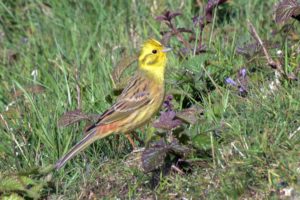 A wide range of birds can be found on farmland across the South Downs, including the grey partridge, lapwing, yellowhammer and skylark.
A wide range of birds can be found on farmland across the South Downs, including the grey partridge, lapwing, yellowhammer and skylark.
Farmland bird species have seen widespread decline across the UK over the past half century, but the South Downs Farmland Bird Initiative was launched six years ago to help reverse this decline.
A collaboration between the National Park Authority, Natural England, the Game and Wildlife Conservation Trust, the RSPB and farmers and landowners, the initiative has focused on introducing nature-friendly farming and restoring priority habitats, including wildflower-rich chalk grassland.
Nature doesn’t recognise farm boundaries so together farmers are supporting endangered species such as the grey partridge.
The project is ongoing and more monitoring studies will be required, but the anecdotal evidence from farmers is there has been an impact.
Farmer Ben Taylor, who manages the Iford Estate near Lewes, spoke of the amazing turnaround on his land, where the creation of new wildlife habitats has seen bird biodiversity flourish from just a handful of species to well over 100.
Ben said: “We’ve achieved profitable farming in the 21st century and it’s allowed us to also provide valuable new wildlife habitats. I really enjoy seeing how farming and conservation can sit neatly side by side. We can look after the environment and, at the same time, produce food for people.
“As you walk along the South Downs you can hear the birds singing. This is such an important migratory point for birds that are coming from the north of England or from further afield and crossing towards Europe. They come here because they have places where they can feed, places to rest and refuel. Ten years ago we didn’t have a great deal of birds, but we’ve now got 140 different species on the farm, and 35 are red-listed because they are so rare. It’s because of the environment they find that they are here.”
For more information see www.sdfarmbirds.com
Rare reptile and amphibian species
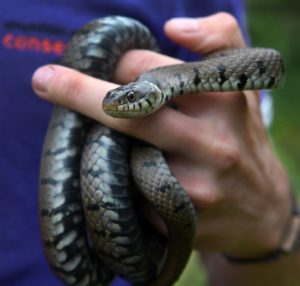 The smooth snake can only be found at a few sandy heathland sites in southern England. The reptile looks a bit like an adder, but lacks the distinctive zig-zag pattern along its back.
The smooth snake can only be found at a few sandy heathland sites in southern England. The reptile looks a bit like an adder, but lacks the distinctive zig-zag pattern along its back.
The Heathlands Reunited Project, led by the National Park Authority and involving 10 partners, has been working to restore our heathlands and ensure this species and other rare reptiles have a brighter future.
The project has also been working to help the natterjack toad, which is found at just a few locations in England and Scotland, where it prefers shallow pools on sand dunes, heaths and marshes. The heathlands of the South Downs National Park provide a vitally-important habitat for the amphibian, whose spring-time mating ritual is the stuff of legend! The males all sing together at night to attract females and their distinctive calls can be heard up to a mile away!
Natterjack toads need a habitat of short vegetation for the active hunting of their prey and will avoid vegetation such as bracken.
Heathlands Reunited, working with the Amphibian and Reptile Conservation charity, has funded four hectares of bracken clearance to improve the quality of the habitat at Woolmer Forest, on the Longmoor Ministry of Defence estate in Hampshire. Longhorn cattle are also playing a vital role in keeping the vegetation height down to help sustain the natterjacks.
Rob Free, Weald Reserves Manager at Amphibian and Reptile Conservation (ARC), said: “The Heathlands Reunited Project has enabled ARC to complete an extra 20 hectares of heathland conservation work on Woolmer Forest, a unique and important expanse of heathland that supports 12 of our native reptile and amphibian species. We were pleased to record that 96 natterjack toad spawn strings were laid at Woolmer in 2019 – which was the second best spawning year for them since our records began in 1970.”
The Round-Headed Rampion and the Pyramidal Orchid
 The Round-Headed Rampion, also known as the ‘Pride of Sussex’, can be found throughout the Sussex and Hampshire Downs. Scrub removal followed by sheep grazing has allowed this chalk grassland specialist to flourish. This has only been possible thanks to partnership working at sites like Old Winchester Hill, where the combined efforts of the SDNPA, Natural England and our Volunteer Ranger Service has really helped the recovery of this species.
The Round-Headed Rampion, also known as the ‘Pride of Sussex’, can be found throughout the Sussex and Hampshire Downs. Scrub removal followed by sheep grazing has allowed this chalk grassland specialist to flourish. This has only been possible thanks to partnership working at sites like Old Winchester Hill, where the combined efforts of the SDNPA, Natural England and our Volunteer Ranger Service has really helped the recovery of this species.
Meanwhile, The Pyramidal Orchid is another chalk grassland favourite in recovery. Scrub management by our volunteers, staff and contractors takes place during the winter months and has helped increase numbers of this beautiful flower.
Duke of Burgundy butterfly

The nationally declining and threatened Duke of Burgundy butterfly responded spectacularly to habitat management work performed as part of the South Downs Way Ahead Nature Improvement Area (NIA), recovering from the brink of extinction and extending its territory. This involved the SDNPA, Wiston Estate, Steyning Downland Trust, and Butterfly Conservation.
In the ‘Chantry to Chanctonbury’ area of the NIA, annual counts rose from 82 to 408 between 2012 and 2014, an increase of 398 per cent.
Further west, at Heyshott Escarpment near Midhurst, peak daily counts rose from 31 in 2012 to 104 in 2014, an increase of 235 per cent.
Wild Trout

The Rother Revival project, with support from The Sussex Lund grant programme and working with Leconfield Estates, is currently under way and focuses on restoring and enhancing a stretch of the western Rother in West Sussex.
The work involves lowering the river bank to help reconnect the river with its floodplain, narrowing the channel to increase flow and introducing woody debris and newly-planted trees to provide valuable habitat for wild fish. The work is helping to reduce erosion and sedimentation – something that will benefit spawning wild trout, which need clear well-oxygenated water and clean gravels to lay their eggs.
Wild trout are excellent indicators of the health of a river – and where they thrive you can be sure that other wildlife will thrive too!
Otters
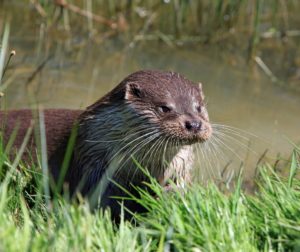 Thought to be locally extinct in Hampshire until a few years ago, otters have made a comeback on the River Meon.
Thought to be locally extinct in Hampshire until a few years ago, otters have made a comeback on the River Meon.
Populations appear to be bouncing back due to less river pollution. The Meon Valley Partnership, which includes the SDNPA and other partners such as the Environment Agency, Portsmouth Water and Hampshire and Isle of Wight Wildlife Trust, has worked with landowners, local fishing groups, and volunteers to help restore river banks and encourage more nature-friendly land management.
It’s believed there are now three breeding females on the River Meon and there are also confirmed sightings of otters on the River Rother.
An adorable wildlife cam video last year of a mother otter and two cubs attracted thousands of views online and was further proof that reductions in river pollution is allowing the secretive mammals to thrive.
Barn owls
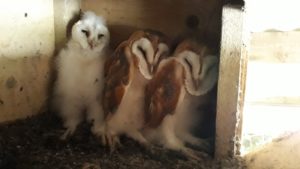 An iconic species of the British countryside, barn owls are an apex predator and a good indicator of the health of the farmed landscape. As a general rule the more barn owls we have, the healthier the eco-system is!
An iconic species of the British countryside, barn owls are an apex predator and a good indicator of the health of the farmed landscape. As a general rule the more barn owls we have, the healthier the eco-system is!
Fifty years ago rural areas had plenty of owl lofts in barns, but many of those barns have been converted or lost over the years.
The National Park Authority and the Sussex Ornithological Society have been working with landowners to reverse this trend and introduce more barn owl boxes. There are now 97 barn owl boxes spread across an area – which stretches from Petersfield to Pulborough – with dozens more across the rest of the South Downs National Park.
Ranger Angela Ward said: “Most of the landowners we work with are very keen to have barn owls back and put up nest boxes, but they don’t have always have the time to do. That’s where the National Park comes in advising farmers on nesting sites and boxes.
“It’s also helps us talk to landowners about habitat for barn owls, as well as all sorts of other species such as ground nesting birds, small mammals and everything going up into the food chain, with barn owls at the top of the food chain.”
Every spring hundreds of people tune in to watch barn owls and their chicks at a specially-designed owl box at a site in West Sussex. See more at the South Downs National Park Barn Owl Watch at https://www.carnyx.tv/LiveCameras/WildlifeCameras/BarnOwl.aspx
Pearl bordered Fritillary

Work by the South Downs Volunteer Rangers is helping to save the regionally endangered pearl-bordered fritillary butterfly by creating special havens for this ‘very fussy’ species in woods on the Norfolk Estate, near Arundel, in West Sussex.
The pearl-bordered fritillary declined by 95 per cent nationally between 1976 and 2014 but has been hit hardest in the south east. The butterfly is now extinct in Kent and Surrey and there are only a handful of colonies left in Sussex and Hampshire, one the result of a successful re-introduction programme.
However, its fortunes are on the up following “Fritillaries for the Future” – a three-year project led by Butterfly Conservation with the South Downs National Park Authority and supported by the Heritage Lottery Fund.
The work involved volunteers hand-cutting bays into the edges of sweet chestnut coppice – creating the perfect breeding habitat for the butterfly.
Last year saw impressive counts for the butterflies, with the count reaching 243 over six areas – the highest count since 2011.
